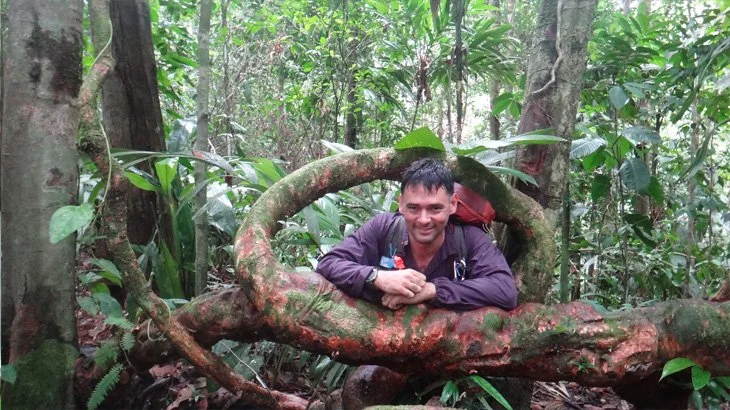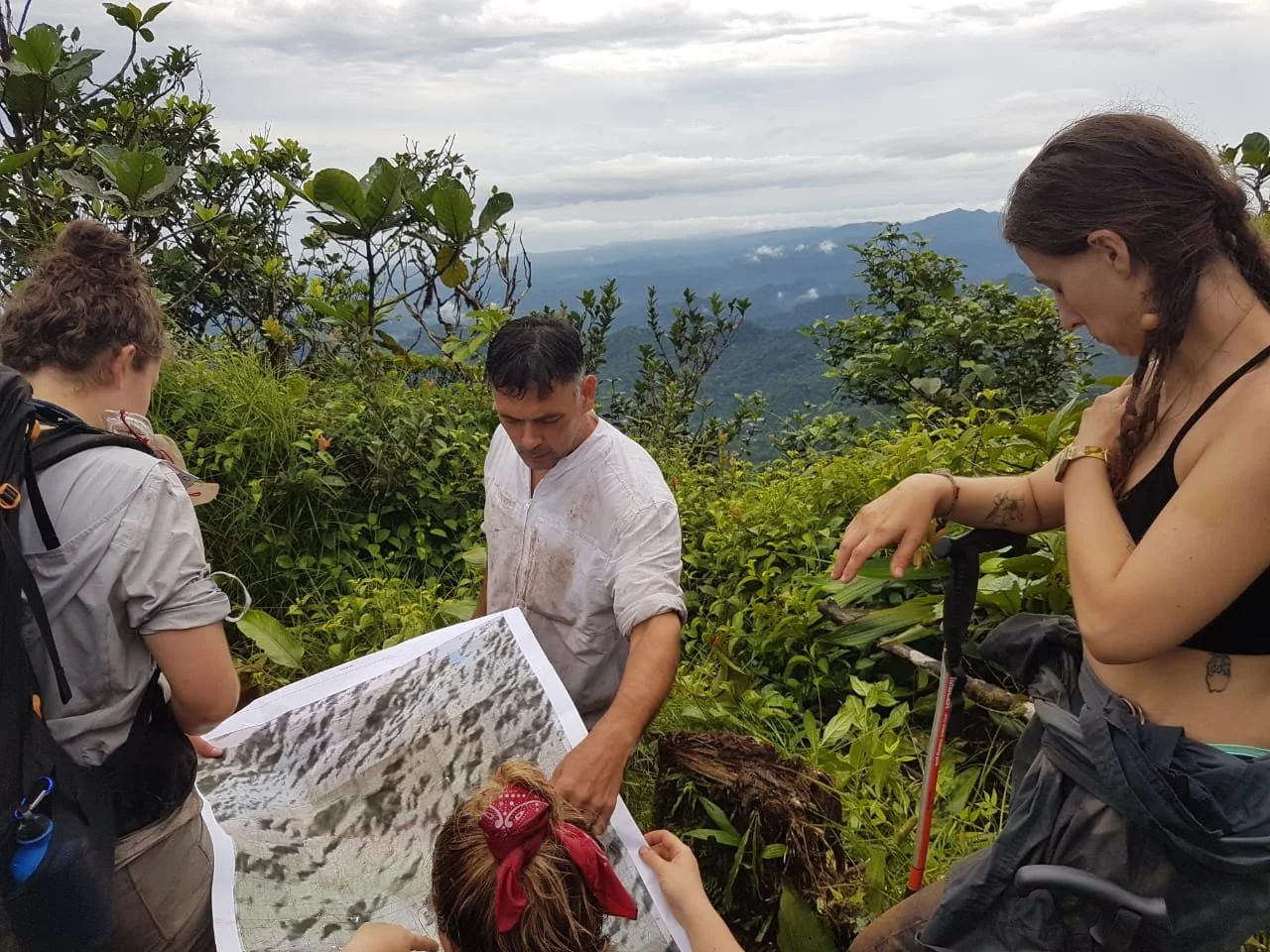Bridging Worlds in the Jungle: The Story of Rick Morales & Beatriz Schmitt
This week, we sat down with two remarkable individuals whose work is helping to shape the future of conservation and sustainable tourism in Panama’s remotest jungles.
In Panama’s dense, mist-draped jungles—where macaws screech overhead and the trees whisper with centuries of memory—two individuals are quietly reshaping the future of conservation and community-based tourism. Rick Morales, a renowned and veteran jungle guide, and Beatriz Schmitt, a seasoned UN advisor and community strategist, have built their lives around a shared belief: that the best way to protect wild places is to empower the people who live closest to them.
Their paths began in vastly different ways. Rick grew up surrounded by the mountains of Panama, a shy kid with little interest in sports and few distractions. Everything changed during a family picnic in a remote mountain valley. “It was like opening a portal into a new world,” Rick remembers. “The call of the wilderness has never really left me since.”
Beatriz, by contrast, began her career in global institutions, working for the United Nations and various NGOs, with a focus on health, development, and Indigenous rights. She’s led strategic programs in remote communities, often navigating complex political terrain while advocating for education, sustainable livelihoods, and environmental stewardship. But her connection to Panama’s wilderness runs deep. She was also the first director of Fundación Avifauna, a bird conservation NGO she helped shape and continues to support as president of its board.
Walking the Length of a Country
In 2011, Rick took on a challenge that would not only change the course of his own life, but also deepen his partnership with Beatriz. He became the first person to thru-hike Panama from border to border—avoiding highways and roads entirely—traversing jungle, remote Indigenous territories, wild beaches, and rugged farmland.
The idea began with a shared dream among Panamanian conservationists: to create a trail that followed the Continental Divide across the entire country. Rick had contributed to the mapping effort with the Trans Panama Foundation, but the project had stalled due to a lack of funding. Determined not to let the vision die, he decided to hike the whole thing himself—to finish mapping the route and prove it could be done. But few believed he would succeed.
“Ultimately no one took me seriously,” he recalls. “That was until I mentioned it to Beatriz. We were just acquaintances at the time, but she got very excited and said she would help me accomplish the project. And she did. Without her, I probably would’ve had to bail out early.”
The expedition began deep in the Darién Gap, one of the most biologically intense and logistically challenging regions in the Americas. What was meant to be a three-day leg to the Colombian border turned into a five-day struggle through dense jungle and dwindling supplies. Rick remembers using the last few drops of hand sanitizer to heat rice and beans. He accidentally sent his hammock and tarp back to Panama City, forcing him to sleep in borrowed gear until they reunited with Beatriz.
“It was a rough start,” he admits. “And I really thought—if it’s this hard already, how will we make it through three months?” But they persevered. Nearly 90 days later, Rick emerged on the opposite end of the country, having completed one of the most ambitious jungle treks in Panama’s history (lets be real - in ‘jungle history’).
That journey reshaped how he approached guiding. “Before, I measured success by how much wildlife we saw. But during the thru-hike, I realized the real power was in the journey itself. Getting up each day and walking into the unknown—it became a metaphor for life. That’s what led me to start Jungle Treks. I wanted to help others experience that raw, transformative journey.”
Community at the Heart of Conservation
While Rick was navigating wild terrain, Beatriz was often navigating cultural landscapes just as complex. Working with the UN, she focused on supporting Panama’s remote and Indigenous communities—building trust, listening first, and crafting initiatives that respected local traditions.
Her work took her to villages accessible only by boat or foot, where she supported programs in healthcare, education, and environmental resilience. “It’s never about imposing solutions,” she says. “It’s about partnership. You have to ask: what do people value? What are their aspirations? How do we support their goals rather than our assumptions?”
As an outspoken advocate for women in outdoor leadership, Beatriz also helped form an all-female hiking group in Panama. For her, the wilderness is not only a place of biodiversity but also of solidarity, strength, and shared learning. “It’s about showing women—especially those from cities—that they belong in these wild spaces. That they can lead, explore, and protect them.”
A Shared Vision
Though they come from different professional worlds, Rick and Beatriz have found powerful synergy in their collaboration. He brings expedition logistics, naturalist expertise, and decades of on-the-ground knowledge. She brings strategic vision, policy insight, and the ability to bring diverse stakeholders to the table. Together, they form a rare bridge between grassroots action and global strategy.
“We’re both deeply rooted in the jungle,” says Rick. “But Beatriz has this gift for connecting people and making things happen. I focus on the physical journey, the gear, the terrain. She focuses on the human journey—what it all means, who it brings together.”
One of their earliest collaborations was a grassroots program called Cuentos de Fogata (“Tales Around the Campfire”), which invited urban Panamanians to spend a night in nature, sharing stories under the stars. Each event was hosted in a wild location just beyond city limits, and featured guest speakers exploring themes of ecology, heritage, or storytelling. “It became a way to reconnect people to the land,” says Beatriz. “And to each other.”
More recently, the two teamed up to restore a legendary field station in Cana, deep within Darién National Park. Once a haven for researchers and birders, the site had fallen into neglect and was invaded by illegal gold miners. With the help of government allies and local partners, they mobilized an effort to reclaim the site—not as a military base, but as a hub for conservation.
In November 2024, they led a team—including Cuban parrot expert and long-time friends—on an 11-day jungle traverse through cloud forests and lowland rainforest to conduct fieldwork on the endangered Great Green Macaw. Beatriz authored a compelling proposal, and the Ministry of Environment agreed to formally support their work in restoring Cana as a research and eco-tourism site.
This May, as part of the Global Big Day bird count, Beatriz led a team back into Cana, while Rick stayed behind to run a jungle guide training course. It’s a perfect example of how they divide and conquer—each contributing in their own way to the same goal.
Training the Next Generation
Rick’s passion for mentoring local guides runs deep. “There are so many paths within the natural world,” he explains. “You don’t have to be an ornithologist or herpetologist to make a difference. There’s room for everyone—whether you're drawn to Indigenous culture, expedition logistics, or wildlife photography.”
He sees jungle guide training not only as a way to raise professional standards but also as a way to keep young people engaged with their cultural and ecological heritage. “If a foreign traveler is willing to fly across the world to experience your home, your forest, your rivers—then those things must have value. That’s a powerful realization.”
Beatriz echoes this from a development standpoint. “Eco-tourism can be one of the most powerful tools for community development. But only if it’s done with respect. That means training locals, listening to their needs, and making sure they are the ones leading the way.”
She points to one of Panama’s biggest gaps: a lack of structured, accessible training for aspiring guides, especially in remote areas. Through their work with Jungle Guides International (JGI), they hope to change that.
Looking to the Future
Their vision for the next five years is ambitious but grounded. Rick dreams of IAJG becoming the go-to authority for jungle guide training across the Americas—then eventually expanding across all tropical regions. Beatriz sees a network of locally led conservation and tourism initiatives that are self-sustaining, inclusive, and deeply rooted in cultural respect.
One of their immediate goals is to integrate the Jungle Guide Course into Cana, bringing in a new generation of learners to the very site where Rick’s legendary trek began. Simultaneously, they hope to scale their bird monitoring and conservation work—transforming Cana into a model for how eco-tourism, science, and community benefit can align.
“We don’t want to be the heroes of the story,” says Beatriz. “We want to be the facilitators. The mentors. The ones who light the fire, and then step back to let others take the lead.”
For communities, businesses, and travelers who want to get involved, the message is simple: come with curiosity. Ask how you can help. Support local initiatives, endorse ethical training programs, and share the stories of those doing the work on the ground.
Because in Panama’s jungles—as in life—the most powerful journeys are the ones we take together.
If you want to learn more about Rick and Beatriz, they are very present and available on social media. You can also reach out to us at JGI, or directly with Rick through Jungle Treks in Panama.
Please Like and Share - It really helps us!







